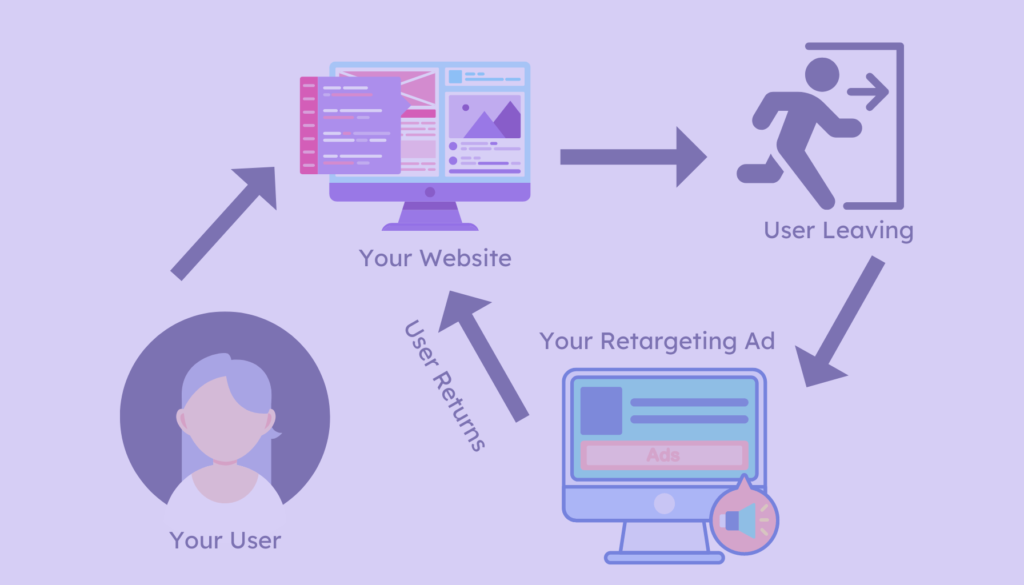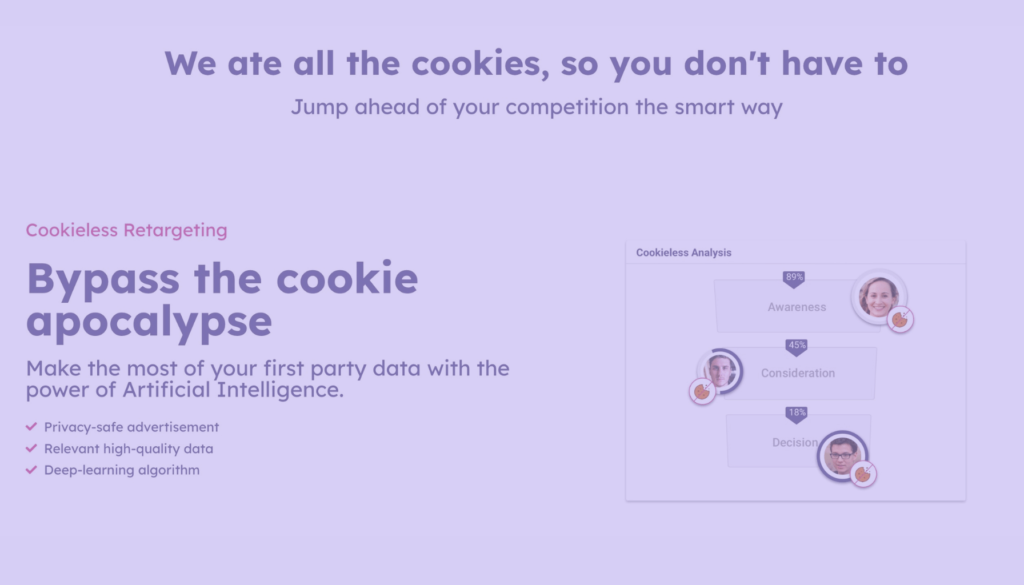
Introduction
Retargeting advertising sets the benchmark for any effective and impactful strategy to reach prospective customers. By showing ads to individuals who have already expressed interest in your products or services, you can improve your chances of making a sale and ultimately increase your ROI. However, retargeting advertising is about to change forever due to a number of factors that are reshaping the digital advertising landscape. Let’s take a look.
2.5x better ad results with cookieless retargeting
Create high-converting retargeting ads based on your users' real-time intent.

Retargeting Advertising in a Nutshell: Why Marketers Love It
Retargeting involves showing ads to users who have already visited a website or interacted with a brand in some way. Up until now, this has been successful through the use of third-party cookies, small files that are stored on a user’s computer or mobile device when they visit a website. A cookie contains information about the user’s browsing behavior, such as the pages they visited, the products they viewed, and the actions they took.
When a user leaves the website, the cookie remains on their device and can be used to track their subsequent browsing behavior.
Social media platforms such as Facebook, Instagram, LinkedIn, Pinterest, Twitter, and TikTok use these cookies to enable you to retarget users who have engaged with your brand on one of those platforms or visited your website. These platforms also allow you to create custom audiences based on user behavior and interests. So far you have also been able to create lookalike audiences to reach users who have similar characteristics to your existing customers.
In addition to social media platforms, retargeting advertising can also be done on digital ad networks such as Google Ads, which offers remarketing options to target users who have visited a website or taken a specific action. Google Ads also allows you to create custom audiences based on user behavior and interests.

One of the main benefits of retargeting advertising is that it allows you to reach out to individuals who have already shown an interest in your products or services. By targeting these users with relevant ads, you can increase the chances of making a sale and ultimately improve your ROI. Retargeting is also cost-effective since you are only showing ads to users who have already shown an interest in your brand, rather than casting a wide net and hoping for the best.
Another advantage of retargeting advertising is that it can help you improve your conversion rates. By showing ads to users who have already interacted with your brand, you are able to build on the trust and familiarity that has already been established. This can lead to higher click-through rates, engagement, and ultimately, conversions.
Additionally, retargeting advertising can be highly personalized. By using cookies and other tracking mechanisms, you can collect data on a user’s behavior and tailor their ads to their specific interests and preferences. Engaging users with this personalized approach can be highly effective in getting them to purchase from your brand.
Taking all this into account, it’s no wonder that marketers, like you, love retargeting advertising and continue to incorporate it into your overall marketing strategies.
The Cookie Apocalypse: The End of Third-Party Cookies
Cookie regulations have become a major concern for businesses that rely on online advertising to reach customers. In recent years, there has been a growing focus on protecting users’ privacy and giving them greater control over how their data is used and shared. With the demand for privacy new regulations have come into play. From the General Data Protection Regulation (GDPR) in the EU to the California Consumer Privacy Act (CCPA) in the United States.
One of the key impacts of these privacy regulations on cookies is the need for you to obtain explicit consent from users before setting cookies or collecting personal data. This means that you must provide clear and transparent information about the types of data you collect, how it will be used, and how users can opt out of tracking. This has led to a significant increase in the number of cookie banners and pop-ups that users see when visiting websites. A slightly more annoying step for our users and an added step in an already complex buying world.
Another impact of privacy regulations is the restrictions on the use of third-party cookies. Third-party cookies are cookies that are set by domains other than the one that the user is visiting, hence third-party, and are commonly used for online advertising and tracking. Regulations such as the GDPR and CCPA require you to obtain explicit consent from users before setting third-party cookies and additionally giving users the ability to opt out of tracking.
In 2019, Google announced that it would phase out its support for third-party cookies in its Chrome web browser within two years. Other web browsers, such as Apple’s Safari and Mozilla’s Firefox, have already implemented similar restrictions on third-party cookies. These changes have been driven by concerns about privacy and security, and the use of third-party cookies for tracking and advertising without the users’ explicit consent.
The impact of the cookie apocalypse on retargeting advertising is significant, as retargeting relies heavily on third-party cookies to track user behavior and serve personalized ads. Without third-party cookies, tracking user behavior across different websites and targeting ads to specific users is significantly harder.
However, there are alternative technologies and strategies that businesses can use to continue retargeting in a post-cookie world.
Alternatives to Cookies for Retargeting Advertising
As the use of third-party cookies becomes increasingly restricted, businesses that rely on retargeting advertising are exploring alternative technologies and strategies to continue reaching their target audiences. Here are some of the most promising alternatives to cookies for retargeting advertising.
1. First-Party Cookies
While third-party cookies are being phased out, first-party cookies are still widely used and are not subject to the same restrictions. First-party cookies are set by the domain that the user is visiting, and can be used to track user behavior and serve personalized ads. Some retargeting platforms are exploring the use of first-party cookies to overcome the limitations of third-party cookies.
2. Contextual Targeting
Contextual targeting involves serving ads based on the content of the web page that the user is visiting, rather than their past behavior. This can be an effective way to reach users who have not interacted with your brand before and can be a useful alternative to retargeting based on third-party cookies. Contextual targeting can also be combined with other targeting strategies, such as geographic or demographic targeting, to create more specific audience segments.

3. Email Retargeting
Email isn’t dead and has in fact become more valuable in this changing environment. Email retargeting involves using email addresses to create custom audiences for retargeting. This can be a particularly effective strategy for businesses that have a large email list and want to reach users who have already expressed an interest in their brand. By using email addresses to create custom audiences, you can serve personalized ads to users who are more likely to convert.
4. Device Fingerprinting
Device fingerprinting is a technology that can be used to identify users based on a combination of device attributes, such as the device type, operating system, and browser. Device fingerprinting can be used to track user behavior across multiple devices, even if cookies are not available. There are tools, like Pathmonk Retargeting, that embrace new-age technologies and remove the reliance on cookies. This cookieless retargeting is based on your users’ intent and buying journey stages.
5. Lookalike Audiences
Finally, AI is providing marketers with a competitive advantage. More and more companies begin to adopt AI in their marketing strategies, and those who fail to do so risk falling behind. By leveraging AI tools, marketers can gain insights into customer behavior and preferences that their competitors may not have access to. This can help them identify new opportunities, stay ahead of trends, and create more effective campaigns that resonate with customers.
The Role of AI in Hyper-Personalized Retargeting
Artificial intelligence (AI) is playing an increasingly important role in the world of digital advertising, particularly in the area of personalized retargeting. With the decline of third-party cookies and the need for more privacy-compliant solutions, AI is becoming a vital tool for businesses looking to reach their target audiences with hyper-personalized, relevant ads.
One way in which AI is being used in personalized retargeting is through predictive modeling. Predictive modeling involves analyzing data to identify patterns and make predictions about future behavior. By using AI algorithms to analyze user data, you can better understand user behavior and preferences, and use that information to serve personalized ads.
When using natural language processing (NLP) AI is pushing personalized retargeting further. NLP is a technology that enables machines to understand and interpret human language. By using NLP to analyze user data, you can gain insights into user preferences and interests, while leveraging that information to serve more tailored ads.
If anything AI is about embracing automation and optimization and it can be used to optimize ad delivery. By using machine learning algorithms to analyze data, you can determine the optimal time, frequency, and format for delivering ads to users. This can help you improve ad targeting and increase the effectiveness of retargeting campaigns.
But to ensure our ad delivery meets both the demands of our users and need to keep up with and leverage technology we can embrace dynamic ads. Dynamic Ads can be personalized in real-time based on user behavior and preferences. By using machine learning algorithms to analyze user data in real-time, you can create ads that are contextual, more likely to resonate with users, and increase the chances of conversion.

How Can Marketers Prepare for the Retargeting Advertising Changes to Come
‘Before anything else, preparation is the key to success’ So we’re here to help you prepare, to futureproof your retargeting advertising efforts. Marketers need to be prepared to adapt strategies to continue reaching audiences effectively. Here are some ways that you can prepare for retargeting advertising changes to come.
- Diversify Targeting Strategies: With the phasing out of third-party cookies, it’s time to explore new ways of targeting your audiences. This includes exploring alternatives to cookies, such as contextual advertising, IP targeting, mobile device ID targeting, and social media retargeting. By diversifying your targeting strategies and embracing next-generation tools, you can continue to reach your audiences effectively.
- Invest in First-Party Data: Focusing on building your own first-party data strategies and sets by collecting data from your own websites, email lists, and other channels, will enable you to create custom audiences for retargeting. You’ll be equipped to better understand your audience’s behavior and preferences.
- Focus on Privacy Compliance: Privacy regulations such as GDPR and CCPA have had a significant impact on digital advertising, and more changes are likely to come. You need to ensure that you are fully compliant with these regulations while being transparent about the way you wield your users’ data. Doing this will foster stronger relationships and build trust with your audiences while simultaneously ensuring your advertising campaigns are effective.

- Embrace AI and Machine Learning: If you don’t embrace it you’ll be left behind. AI and machine learning can play a vital role in personalized retargeting. Investing in AI and machine learning technologies will help us understand our audiences like never before while personalizing and optimizing ad targeting to create more effective campaigns.
- Develop a Cross-Channel Strategy: With the rise of multi-channel marketing, it’s important for marketers to develop a cross-channel strategy that includes retargeting advertising. By integrating retargeting with other marketing channels such as social media, email marketing, and search advertising, marketers can create a more cohesive and effective marketing strategy.
- Build Strong Partnerships: It’s easy to remain isolated but the right partnerships can take our efforts and reach so much further. As the digital advertising landscape continues to evolve, it’s important for you to build strong partnerships with vendors and partners who can help you stay ahead of the curve. This includes partnering with advertising platforms, agencies, and consultants who can provide insights and guidance on the latest trends and technologies. Because we can all admit that we simply don’t know it all.
Conclusion
As rules, strategies, and technologies adapt and change, according to the demands and needs of our consumers, we must adapt and change too.
Personalization is more essential than ever but as marketers rely on third-party cookies to do this effectively, retargeting advertising will no longer be the same. But by exploring and embracing new ways of targeting, using first-party data to create custom audiences, taking advantage of AI and machine learning technologies, and implementing cross-channel strategies we still have the power to personalize retargeting and create cohesive and effective marketing strategies.
More than anything marketers have to focus on privacy compliance if they want to remain a brand of choice. It’s an opportunity to build strong relationships with vendors and partners and invest in diversifying targeting strategies to continue creating effective retargeting campaigns. But if there is anybody who can handle this, it’s marketers.
2.5x better ad results with cookieless retargeting
Create high-converting retargeting ads based on your users' real-time intent.









